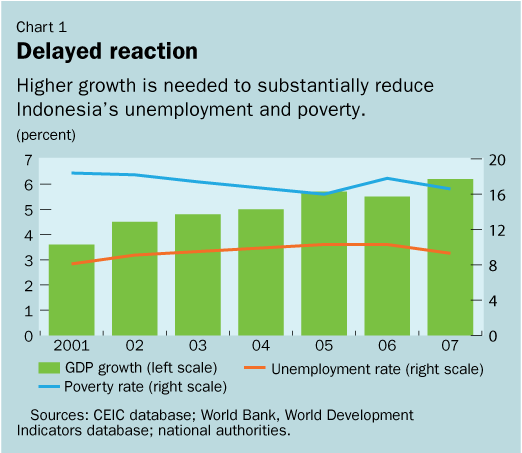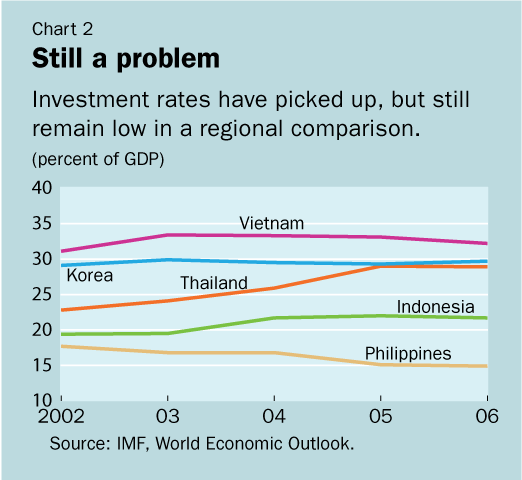DECADE AFTER ASIAN CRISIS

Typical street scene in Santa Ana, El Salvador. (Photo: iStock)
IMF Survey: Indonesia: Sustaining the Recovery
October 10, 2007
- Indonesia's economy in better shape than at any time since Asian financial crisis
- Despite successes, poverty, unemployment remain high, persistent
- Challenge is to further boost growth to improve social conditions
Indonesia's economy has made impressive progress in recent years and is now in its best shape since the Asian crisis devastated the country in 1997-98.

Farmers harvest rice in Java, Indonesia—where poverty rates remain high, reflecting in part rising food prices (photo: Maya Vidon/AFP)
However, poverty and unemployment remain high. Sustained high growth will be needed to realize tangible improvements in social conditions. With the right set of policies, this should be achievable. Suitable policies would include stability-oriented macroeconomic policies to reduce volatility, as well as measures to boost public and private investment.
GDP growth is running at around 6 percent and could pick up further in the period ahead, though clearly there are heightened uncertainties following the recent global financial market turmoil. While growth has been broad based, strong exports led by the commodity price boom have contributed significantly to the good performance.
The current account surplus increased to about 2½ percent of GDP in 2006, supporting the decline in external debt and the buildup of reserves. The strong external position also enabled Indonesia to repay all remaining obligations to the IMF ahead of schedule.
Inflation under control
Despite the pickup in growth, inflation remains under control (see table) and well within Bank Indonesia's target range of 5-7 percent for 2007. Public finances are sound and with small fiscal deficits public debt has been reduced to below 40 percent of GDP and is on a continued declining trend. The banking system is well capitalized and very liquid. Nonperforming loans have declined, profitability is rising, and corporates have deleveraged.

While it is still too early to draw firm conclusions, Indonesia seems to be weathering the recent global financial market turmoil relatively well, in part due to declining vulnerabilities. Following a substantial runup in Indonesian equities and bonds over the past two years, in late July and early August the global drop in risk appetite caused a flight to quality.
Indonesian assets—generally regarded as comparatively risky—took a significant hit. At the height of the selloff, the equity index had declined 20 percent from the all-time high reached in July. However, as global financial markets calmed down, Indonesian equity and bond markets quickly and fully recovered.
Factors that helped to limit the impact of the market turmoil include Indonesia's relatively low external financing needs due to the current account surplus and lower external debt; a sound fiscal position and declining debt ratios; strong international reserves; and little, if any, direct exposures to the U.S. mortgage market and structured credit products.
At this point, prospects for continued GDP growth of around 6-6½ percent in 2007 and 2008 look good, but uncertainties about the impact of the U.S. mortgage crisis on global growth, commodity prices, risk appetite, and capital flows to emerging markets present downside risks.
Need for tangible results
However, notwithstanding the recent economic improvement, poverty and unemployment remain high and persistent (see Chart 1). Supported by high commodity prices, recent investment and growth have disproportionately benefited capital intensive sectors such as mining.

At the same time, labor intensive manufacturing industries, including textiles, footwear, and electronics, have suffered from restrictive labor regulations and strong competition in the region. As a result, the increase in growth has not generated sufficient employment opportunities in the formal economy to significantly lower unemployment. Meanwhile, poverty rates have remained high, reflecting in part rising food prices—though a small decrease in poverty in 2007 is encouraging.
The government therefore aims to boost GDP growth to at least 7 percent to realize tangible improvements in social conditions. While this is an ambitious target, it should be achievable with the right set of macroeconomic and structural policies.
Policies to reduce volatility
Since the Asian crisis, Indonesia's economy has been very volatile. In Indonesia's narrow financial markets, shifting capital flows have led to significant swings in the exchange rate, with ramifications for domestic asset prices, inflation, interest rates, and real activity. Such movements have often been triggered by global factors—as in the recent episode of financial market turmoil. However, markets tend to react more strongly in countries that are considered riskier, and markets' assessment of risk is often related to the perceived strength and credibility of macro policies.
To reduce volatility, it will thus be important to maintain confidence in proactive and predictable macroeconomic management. To build on the progress made over the past two years, monetary policy should remain focused on inflationary developments. Since its introduction in 2005, the inflation targeting regime has been a success.
However, efforts are still needed to achieve the medium-term goal of reducing inflation to levels of major trading partners (about 3 percent). Establishing credibility will necessarily take some time, especially since, historically, inflation has rarely been below 5 percent. It will also require clearly communicating the priority of the inflation target, as well as setting interest rates appropriate to achieving that objective.
Fiscal policy has been successful in reducing the large public debt burden that remained after the Asian crisis. Continued declines in debt ratios are envisaged and will improve stability by further reducing vulnerabilities. Indeed, fiscal policy should now increasingly focus on creating and using fiscal space to ramp up priority spending.
Achieving higher investment
The lack of adequate infrastructure is increasingly creating supply bottlenecks, as public infrastructure investment has dropped sharply after the Asian crisis. Increasing infrastructure investment is thus a key priority of the government. This includes increasing the participation of the private sector through public-private partnerships, and a sound framework has been put in place. However, preparing and implementing sound projects has taken time and a significant increase in on-budget infrastructure investment appears needed.
In addition to public investment, private sector investment also remains low compared with prior to the Asian crisis, but also in a regional comparison (see Chart 2). Achieving ambitious growth targets will require higher private investment rates. Two elements are important in this context: improving the investment climate and ensuring availability of financing.

The investment climate remains a central problem in Indonesia. While some improvements have been achieved, Indonesia still compares poorly in cross-country surveys. In particular, strict labor legislation and a difficult legal and regulatory environment are considered impediments for higher investment, including foreign direct investment. The government has made progress in some areas. A new investment law and a key tax law were passed recently and should help make the regulatory environment more business friendly.
Long-term financing
Finally, sources of financing need to be improved. Credit to the private sector fell sharply during the Asian crisis and still remains far below precrisis levels as a share of GDP. Staff analysis suggests that, to a large extent, this reflects a lack of demand from creditworthy investors. Improving the legal environment and the investment climate will likely increase that demand.
However, efforts are also needed to increase the supply of long-term financing. Bank credit in Indonesia generally has a short maturity as banks aim to match the short maturity of deposits. Developing domestic capital markets and the nonbank financial sector should improve the availability of financing and remains a priority.
Overall, much progress has been achieved in recent years. The economy is good shape and less vulnerable to external shocks. The challenge will be to build on those successes and further boost growth to achieve tangible improvements in social conditions. This requires policies to boost public and private investment—in particular, structural reforms to improve the investment climate, support infrastructure investment, and enhance financial intermediation. In addition, stability-oriented macroeconomic policies are critical to reduce volatility and strengthen confidence in Indonesia's economic performance.







